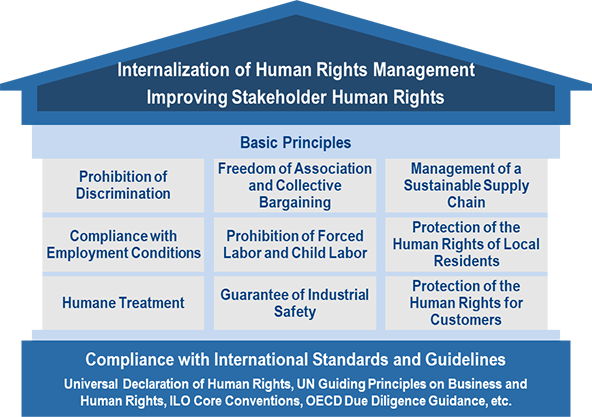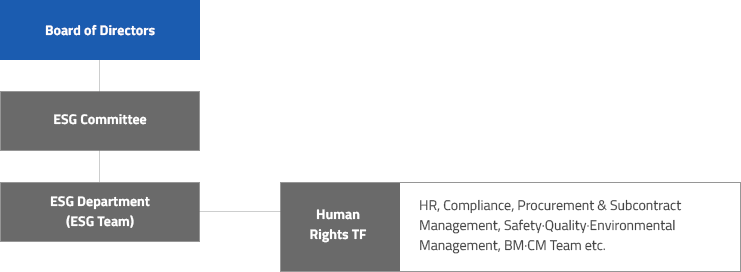Human Rights Management
Human Rights Management System

인권경영 내재화 이해관계자 인권 향상
기본 원칙
- 차별금지
- 결사 및 단체교섭 자유 보장
- 책임있는 공급망 관리
- 근로조건 준수
- 강제노동 및 아동노동 금지
- 지역주민 인권 보호
- 인도적 대우
- 산업안전 보장
- 고객 인권 보호
국제 표준 및 가이드라인 준수
세계인권선언, UN 기업과 인권 이행원칙, 국제노동기구 핵심협약, OECD 실사 가이드라인 등등
Human Rights Management Policy
This policy applies to all directors, officers, employees, and subsidiaries of GS E&C in all their functions and at all locations worldwide, including joint ventures that GS E&C enters. We also expect our business partners, suppliers and contractors to comply with fundamental Human Rights.
- Human Rights Management PolicyOpen/Close
Human Rights Management Implementation Organization
GS E&C has established a systematic governance structure to enhance employees’ awareness of human rights and to mitigate human rights risks. The ESG Committee under the Board of Directors serves as the highest decision-making body for the implementation of human rights management, making key decisions on significant human rights issues. Relevant departments, including the ESG Team, are responsible for executing human rights management practices through the Human Rights TF.

- 이사회
- ESG 위원회
- ESG부문(ESG팀)
- 인권TF
- HR, Compliance, 조달, 안전·품질·환경, BM관리, 본부CM팀 등
Human Rights Risk Management
Human Rights Risk Management System

- Enactment and declaration of the Charter of Human Rights
- Establishment/implementation of human rights management
- Inspection and evaluation of human rights risks
- Helping to reduce human rights risks
- Disclosure of human rights management performance
Human Rights Due Diligence Process

- Human Rights Impact Assessment
- Human Rights Risks Identification
- Human Rights Survey
- Self-Assessment on Human Rights
- Employee Interviews
- Human Rights Risks Assessment
- Key management items are selected based on likelihood, severity, and the company's current status.
- Human Rights Risks Identification
- Mitigation Planning and Execution
- Awareness Improvement for Employees(Training, Campaigns)
- Improvement of Systems and Procedures
- Preventive Actions & Monitoring
- Effectiveness Assessment
- Measure effectiveness through regular comparative improvement
- Implement corrective actions for identified shortcomings
Supply Chain Human Rights Management
GS E&C includes its partners and some subsidiaries within the scope of human rights due diligence. Through human rights surveys, the company identifies human rights risks in the supply chain, shares its human rights management policy, and clearly defines the obligation for partners to comply with the Code of Conduct. Additionally, GS E&C promotes awareness of human rights through education and campaigns.
Relief Procedure for Human Rights Violations
GS E&C operates a grievance handling system to promptly and fairly resolve issues reported through various reporting channels. We ensure confidentiality for whistleblowers and victims, and take measures to protect them from any disadvantage or retaliation.
- Counseling/
Reception -
- Type: Verbal abuse, physical assault, personal insults, sexual harassment, bullying, unfair work orders, etc. (Workplace harassment)
- Reporting Channels: Cyber reporting system, email, phone, in-person visit
- Investigation: Investigator designated by the Compliance Team
- Investigation
-
- Review of the report and evidence
- Separate interviews with the victim, perpetrator, and witnesses
- During the investigation, depending on the case, the victim and perpetrator may be separated in the workplace or placed on paid leave
- Results
Reporting -
- If it is deemed a human rights violation, appropriate personnel or disciplinary action will be taken depending on the severity.
- If it is not considered a human rights violation, the parties involved will be notified and the case will be closed.
- Remedial
Actions -
- Provide feedback to the whistleblower on investigation results and actions taken
- Conduct monitoring to prevent secondary and tertiary harm
- Report the status of human rights violation cases and investigations to the Ethics Committee









